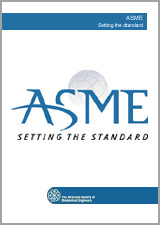We need your consent to use the individual data so that you can see information about your interests, among other things. Click "OK" to give your consent.

ASME OM-2:2024
Component Testing Requirements at Nuclear Facilities
Translate name
STANDARD published on 2024
The information about the standard:
Designation standards: ASME OM-2:2024
Publication date standards: 2024
SKU: NS-1206348
The number of pages: 83
Approximate weight : 280 g (0.62 lbs)
Country: American technical standard
Category: Technical standards ASME
Annotation of standard text ASME OM-2:2024 :
Inservice testing (IST) is used at nuclear facilities to examine, test, and monitor pumps, valves, and dynamic restraint devices. ASME OM-2, Component Testing Requirements at Nuclear Facilities, is a component code intended to be used for IST at nuclear facilities of various designs. ASME OM, Operation and Maintenance of Nuclear Power Plants, provides requirements for the performance of IST at water-cooled nuclear power plants. The purpose of IST is to test, examine, and monitor pumps, valves, and dynamic restraint devices to ensure the operational readiness of the component to perform its specified functions. Both ASME OM and ASME OM-2 accomplish this by trending degradation so that such degradation can be detected and remedied prior to the component being incapable of performing its specified functions. ASME prepared ASME OM specifically for light water reactors (LWRs). Additionally, ASME made several accommodations in ASME OM in the testing of components because many components cannot be fully tested with the nuclear power plant online. A reason for this is that ASME prepared ASME OM after many of those plants were built and operating. With the expansion and evolution of the nuclear industry to facilities that are significantly different than the currently operating LWRs, ASME recognized that another code, ASME OM-2, for IST of components in new and advanced reactors was needed. ASME designed ASME OM-2 with the basic prerequisite that components that are to be part of the IST program for these new facilities are appropriate for the functions that they are to provide, that they are correctly sized and specified for the parameters of the system in which they are to be installed and operating, and that the materials of their construction are compatible with the system fluid conditions, pressures, temperature, and chemistry.
We recommend:
Technical standards updating
Do you want to make sure you use only the valid technical standards?
We can offer you a solution which will provide you a monthly overview concerning the updating of standards which you use.
Would you like to know more? Look at this page.



 Cookies
Cookies
